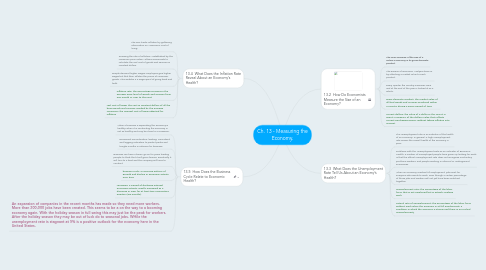Ch. 13 - Measuring the Economy.
by MORGAN SANDERS

1. 13.2 How Do Economists Measure the Size of an Economy?
1.1. The main measure of the size of a nation's economy is its gross domestic product.
1.2. The Bureau of Economic Analysis does so by attaching a market value to each product.
1.3. Every quarter the country measures GDP and at the end of the year is looked at as a whole.
1.4. gross domestic product: the market value of all final goods and services produced within a country during a given period of time
1.5. current dollars: the value of a dollar in the year it is spent; a measure of the dollar’s value that reflects current purchasing power, without taking inflation into account
2. 13.3 What Does the Unemployment Rate Tell Us About an Economy’s Health?
2.1. The unemployment rate is an indicator of the health of an economy. In general, a high unemployment rate means the overall health of the economy is poor.
2.2. Problems with the Unemployment Rate as an Indicator of Economic Health: a number of unemployed people have given up looking for work, is that the official unemployment rate does not recognize involuntary part-time workers, and people working in informal or underground economies.
2.3. When an economy reaches full employment, jobs exist for everyone who wants to work, even though a certain percentage of those jobs and workers will not yet have been matched together.
2.4. unemployment rate: the percentage of the labor force that is not employed but is actively seeking work
2.5. natural rate of unemployment: the percentage of the labor force without work when the economy is at full employment; a condition in which the economy is strong and there is no cyclical unemployment]
3. 13.4 What Does the Inflation Rate Reveal About an Economy’s Health?
3.1. The BLS tracks inflation by gathering information on Americans’ cost of living.
3.2. Knowing the rate of inflation—established by the consumer price index—allows economists to calculate the real cost of goods and services in constant dollars.
3.3. People demand higher wages, employers give higher wages but that then inflates the prices of consumer goods. This enables a a wage-spiral of going back and forth.
3.4. inflation rate: the percentage increase in the average price level of goods and services from one month or year to the next
3.5. real cost of living: the cost in constant dollars of all the basic goods and services needed by the average consumer; the nominal cost of living adjusted for inflation
4. 13.5 How Does the Business Cycle Relate to Economic Health?
4.1. When a business is expanding the economy is healthy, when it is contracting the economy is not as healthy and may be close to a recession.
4.2. Economist use indicators: leading, coincident, and lagging indicators to predict peaks and toughs months in advance for business.
4.3. Business can have a boom go on for years leading people to think that it will goon forever. Eventually it will turn to a bust and the company will have to contract.
4.4. business cycle: a recurring pattern of growth and decline in economic activity over time
4.5. recession: a period of declining national economic activity, usually measured as a decrease in GDP for at least two consecutive quarters (six months)
4.6. An expansion of companies in the recent months has made so they need more workers. More than 200,000 jobs have been created. This seems to be a on the way to a booming economy again. With the holiday season in full swing this may just be the peak for workers. After the holiday season they may be out of luck do to seasonal jobs. WHile the unemployment rate is stagnant at 5% is a positive outlook for the economy here in the United States.


